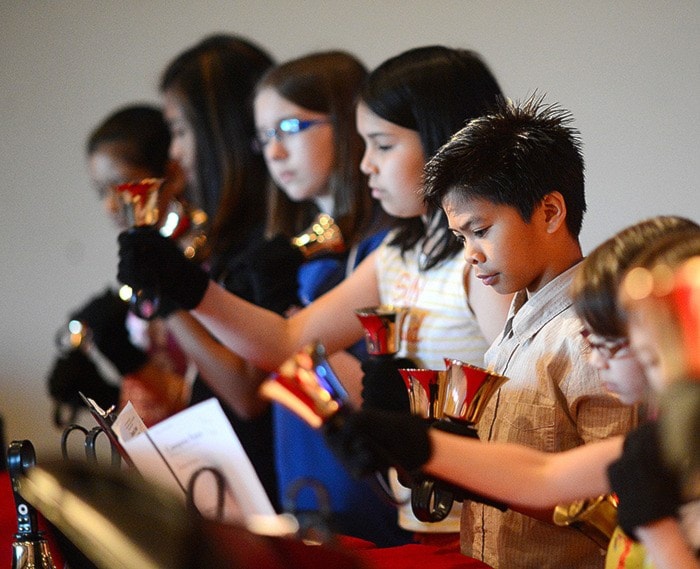 Each Thursday when the bell rings at 2:37 p.m., most students at Berkshire Park Elementary grab their knapsacks and head out the door.
Each Thursday when the bell rings at 2:37 p.m., most students at Berkshire Park Elementary grab their knapsacks and head out the door.
But three minutes later, at 2:40 p.m., 13 students get together for more bell-ringing.
Berkshire Park Elementary, at 15372 94 Ave., is the only public school in Surrey that has an English handbell club, led for a second year by music teacher Elaine Esau.
That 10 students returned from the program’s first year as an optional after-school activity is telling – one deep, protracted ding (or dong, depending on the size) of a brass handbell can be marvelous.
“They make a beautiful sound, really, they do,” Esau says.
In the school district, music classes are mandatory from kindergarten to Grade 4 and some schools have other music options for older kids.
But not normally handbells.
Esau says the reason that handbell choirs are so scarce is that the handbells themselves are rare. The school’s handbells sat silent for years at Cloverdale United Church (see below) before being loaned to the school.
It’s a set of 36 bells, good for three octaves (including sharps and flats) – a solid, basic set for beginners, notes Esau.
The teacher also gives a visitor a little history lesson, describing how handbells were first used in medieval times to summon people to church.
Initially, they were used in mathematical patterns, but not melodies.
Melodies only arrived in the 1600s when the first tuned sets of handbells were made.
“That’s when they started handbell choirs.”
They’re still called that – choirs – even though no voices are involved.
The students keep coming back for the sound.
“Even when they play at the wrong (timing), it sounds cool,” says Esau.

Photo: Elaine Esau is the Surrey School District’s only handbell choir instructor.
Handbell ringing is certainly more difficult than it looks and it’s not the type of music one can practise at home.
It takes precise concentration, timing and teamwork, since each student is usually responsible for only two bells, and two notes within each song.
They’ll stick with the same two bells, as well as corresponding sharps or flats, for most of the year.
“It requires intense concentration,” Esau explains. “They have to listen to one another and constantly be counting.”
Esau describes the entire choir as being one piano player – each student is one finger. If one kid misses practice, it’s like a missing key on a piano.
“A lot of it is muscle memory. They’re remembering when to ring and if they have to switch parts, it’s like starting (training) over.”
It’s good for memory, coordination and discipline – like a team sport, she adds.
“It’s a good workout for the brain. Just like with any other musical instrument, anything that you do, whether it’s singing in a choir, or playing in the band, you’ve go the options of moving on with music.”
But handbell music itself can accelerate with experience.
“Once you get more advanced, you can play with mallets, or you can make percussive sounds… there are different ways of holding and ringing the bells,” Esau says.
In uber-advanced adult choirs, one player may be responsible for six or seven bells sitting on a table in front of them.
For the Berkshire Park students, it does help if they have piano experience and can read music, but for those who don’t, Esau prepares colour codes on the song sheets.
For the more complex techniques, the sheets have abbreviations and notations that are unique to the instrument. They include LV (laissez vibrer), SK (shake), TD (thumb damp), PL (pluck) and SW (swing).
Naturally, handbell music can sound “churchy,” and is a perfect fit for school district Christmas concerts, but the Berkshire Park Elementary students have also played at the school and have plans for a Christmas concert at Queen’s Avenue United Church in New Westminster.
The bells’ history
The bells used at Berkshire Park Elementary were donated to Cloverdale United Church in 1986 by Lydia Rowles, who passed away a few months later.
Choir member Steven Johnston agreed to lead a handbell choir, and of 21 people who signed up, 14 joined and stayed for several performances from Oct. 19 to Christmas.
The choir was then disbanded after Johnston was unable to continue leading it as its teenage members were too busy with other things.
The bells were stored in a locked cupboard until 2001, when former church choir leader David Proznick borrowed the bells for his choir at Crescent United Church and, on another occasion, a summer music class at Camp Kwomais.
In the fall of 2001, Ivy Charyna of Hazelmere United Church borrowed the bells to train and direct a small group who then performed at “Carols in the Country” on Dec. 10, 2001.
The bells were later returned to Cloverdale United Church, where they remained until being loaned to Berkshire Park Elementary – with assistance from Virginia Barteluk of the handbell choir at Queen’s Avenue United Church in New Westminster.
Three of the original groups of bell ringers are still members of Cloverdale United Church: Judy Cook, Thelma Smidt and Dora Rogers.
– with files from Dora Rogers
